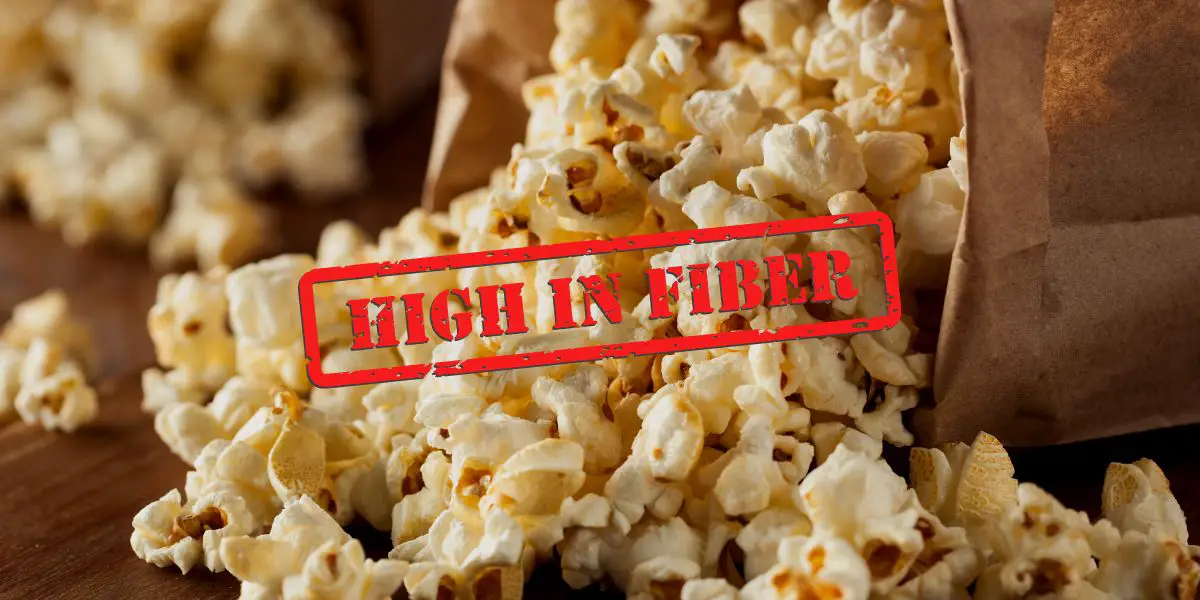Popcorn is one of the best snacks you can eat when you want to increase your fiber intake.
Fiber is needed to keep your gut healthy and prevent constipation. It can even help you to live longer and prevent diseases such as type 2 diabetes and obesity.
Let’s find out more about the fiber content of popcorn and how much popcorn you should eat to make sure you’re getting enough fiber in your diet.
Is Popcorn a Good Way to Get Fiber?
Yes, popcorn is a good way to get fiber.
Fiber is crucial for keeping your stools healthy and regular, so you need to make sure that you’re eating enough of it.
However, studies have found that 93% of the population doesn’t eat enough fiber. It was recently reported that just 5% of men and 9% of women eat the recommended daily intake of fiber.
How Much Fiber Should You Eat Each Day?
The amount of fiber you need depends on your age. As a general rule, you should aim for the following amount of fiber every day:
- Women aged 50 and under – 25 to 28 g per day
- Men aged 50 and under – 31 to 34 g per day
- Women aged 51 and older – 22 g per day
- Men aged 51 and older – 28 g per day
- Under 18-year-olds – between 14 and 31 g per day
How Much Fiber is in Popcorn?
Air-popped popcorn contains 1.15 g of fiber per cup. A typical serving of popcorn is between 3 and 4 cups. This means you could add more than 4 g of fiber to your diet every time you snack on popcorn.
Why Does Popcorn Contain so Much Fiber?
Popcorn contains a lot of fiber because it’s a whole grain. Whole grains naturally contain fiber and are made up of three parts; bran, germ, and endosperm. The bran is the part that is rich in fiber.
What’s the Best Way To Add Popcorn To Your Diet?
Now you know that popcorn contains a lot of fiber, you’re probably thinking about how to add more of it to your diet. The great thing about popcorn is that you can eat it at any time of the day or night. It’s also great for snacking on when you’re on the go or need a quick pick-me-up.
Here are some simple ways to add popcorn to your diet so that you benefit from more fiber:
- Swap your daily packet of chips for popcorn
- Have popcorn for dessert rather than chocolate chip cookies
- Plan a regular movie night so you’ve got an excuse to tuck into some popcorn
- Keep a bag of popcorn on your kitchen worktop so you can dive into it when you’re waiting for the kettle to boil
What Type of Fiber is in Popcorn?

Popcorn is a whole grain so the fiber in it is mostly insoluble. Insoluble fiber is crucial for staying healthy and has the following benefits:
- Prevents constipation
- Keeps the colon healthy
- Lowers the risk of diverticular disease – a condition that causes bulging pouches in the colon
- Keeps you feeling fuller for longer (which may aid weight loss)
- Reduces the risk of developing some cancers
What Type of Popcorn Has the Most Fiber?
Air-popped popcorn is the healthiest way to enjoy popcorn and benefit from its fiber content.
If you opt for microwave varieties, movie-theater popcorn, ready-popped popcorn, or popcorn smothered in toppings, the benefits will be lost.
These types of popcorn are usually high in calories, saturated fat, salt, and sugar. Ingredients like this can be bad for your health and cause problems such as obesity, high cholesterol levels, and hypertension.
Check out our guide on popcorn nutrition.
How Much Popcorn Should You Eat To Get Enough Fiber?
As a general rule, stick to eating one serving of popcorn each day. This will make a real dent in your recommended daily fiber amount. You can then rely on other foods to get the rest of your fiber intake.
Each meal that you eat should contain fiber as this is the best way to reach the recommended daily amount. Some great ways to add more fiber to your meals include:
- Adding a handful of berries to cereal
- Switching mince for legumes
- Adding seeds or nuts to your meals
- Grating carrot or zucchini into dishes
- Adding one extra vegetable to every meal you make
Do Popcorn Toppings Contain Fiber?
The most popular popcorn toppings, such as cheese, salt, sugar, and caramel, don’t contain fiber. But you can mix your popcorn with other high-fiber foods to boost your fiber intake even further. Some great options include:
- Chopped apple
- Mixed berries
- Dried fruits
- Nuts
Check out our article on how to make caramel popcorn.
What Other Snacks are High in Fiber?
There’s a good chance that you’re one of the 94% of the population that snacks daily. If you’re snacking on popcorn, then you’re already making a good choice, but there are other high-fiber snacks that you should consider too, including:
- Avocado
- Raspberries
- Apples
- Oat bran muffin
- Almonds
- Carrots with hummus
Fiber is one of the most important parts of your diet and it’s likely that you’re not eating enough of it.
You’re probably relieved to hear that popcorn is high in fiber as you can indulge in it without feeling guilty. But make sure you stick to air-popped popcorn where possible to ensure your health benefits from this delicious snack.
Sources
https://www.insider.com/guides/health/diet-nutrition/is-popcorn-healthy
https://graciouslynourished.com/soluble-fiber-food-chart-and-benefits/
https://healthyeating.sfgate.com/benefits-insoluble-fiber-5526.html
https://www.healthline.com/health/food-nutrition/how-much-fiber-per-day
https://www.inthekitchenwithmatt.com/most-popular-desserts-in-america
https://www.ucsfhealth.org/education/increasing-fiber-intake




